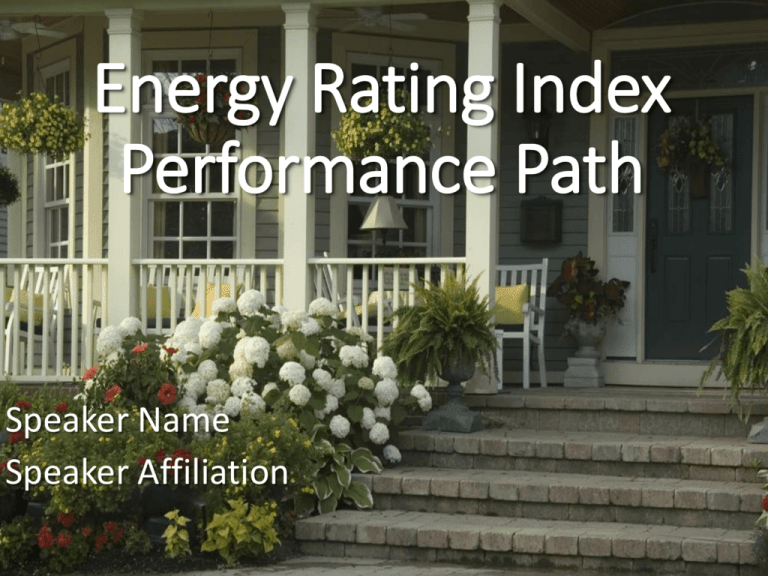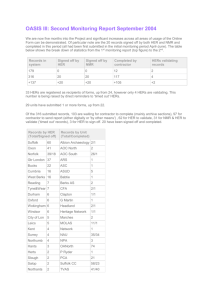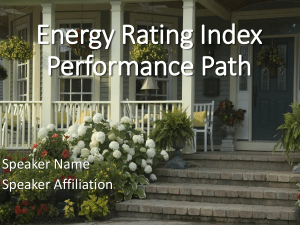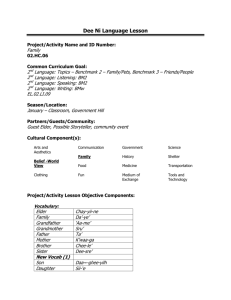Commercial Hot Water Systems
advertisement

Energy Rating Index Performance Path Speaker Name Speaker Affiliation Goals of the Concept Increase compliance for residential energy codes Increase building energy savings through increased compliance Complement existing performance-based residential efficiency programs Create cost-effective retrofit and new build strategies to exceed minimum code requirements Overview of the ERI Performance Path ERI Performance Path • Additional option for IECC compliance • Target ERI score is met through a wide range of performance options • Requires builders to achieve the mandatory code requirements of the 2015 IECC and comply with minimum insulation and window envelope performance requirements of the 2009 IECC Mandatory Requirements 2015 IECC provisions including: Section R402.4 Air Leakage Section R403 Systems Section R403.5 Service Hot Water Systems Section R404 Electrical Power and Lighting Systems Building Envelope requirements of the 2009 IECC States and jurisdictions can specify which qualifying ERI method they will use RESNET HERS Index is the existing compliance ERI method • Is nationally recognized • Based on ANSI RESNET Standard 3012014 • To date, over 1.5 million homes have been rated in the US under the RESNET standards What is a HERS Index and Score? A scoring system established by RESNET based off of the 2006 IECC The scale is based on a 100 – 0 index A home based on the 2006 IECC scores a HERS Index of 100 A score of 0 is equivalent to a net zero home 2015 IECC Target ERI Scores The ERI score is defined as a numerical score where 100 is equivalent to the 2006 IECC and 0 is equivalent to a netzero home. Each integer value on the scale represents a one percent change in the total energy use of the rated design relative to the total energy use of the ERI reference design. 2015 IECC Target ERI by Climate Zone Climate Zones 1-2: 52 Climate Zone 3: 51 Climate Zone 4: 54 Climate Zone 5: 55 Climate Zones 6: 54 Climate Zones 7-8: 53 What is included in an Energy Rating? Energy ratings are based on a number of variables including the type and efficiency of each of the following: Equipment Appliance upgrades Exterior walls (both above and below grade) Floors over unconditioned spaces (such as garages or crawlspaces) Ceilings and roofs Attics, foundations and crawlspaces Windows and doors, vents and ductwork HVAC and water heating systems Air leakage of the home Leakage in the heating and cooling distribution system Who is Using the HERS Index? • To date, jurisdictions in seven states have incorporated a HERS Index Score option into their residential code: • Arkansas • Colorado • Idaho • Kansas • New Mexico • New York • Massachusetts Benefits of the Energy Rating Index Score Option From a Code Official’s Perspective • Reduction in Compliance Verification Time • Quality Assurance • Building Performance From a Code Jurisdiction’s Perspective • National Standard based on US DOE/US EPA Best Practices • Improved Review and Approval Process and Time • 3rd Party Certified Inspections Demonstrating Compliance • Certification Testing to Obtain Final HERS Score • Ability to Adopt/Promote Whole House Performance Standards From an Environmental Perspective • Decreased Emissions • Reduced Energy Bills Cleanenergy.org Energy Rating Index Implementation Guidelines The ERI compliance path, implemented through the HERS rating process, provides independent, third-party analysis and review of the energy using features of a house. The process includes: • Initial analysis and energy rating of the proposed home • Review for compliance with the energy code • The inspection and testing of energy using features in the home to ensure that they perform as proposed • Completing a final energy rating of the home once completed The thoroughness of the HERS rating process reduces the need for the jurisdiction to conduct plan review and specific inspections focused on compliance with the energy code HERS Rater Certifications HERS Raters must be experienced and educated in conducting, supervising The following RESNET HERS certifications and evaluating a HERS demonstrate competency in this field: rating Home Energy Rater Certification Rating Field Inspector Certification (can only provide the infield testing and inspection but not certified to provide an ERI) It is recommended that HERS Raters demonstrate knowledge of the provisions of the IECC by holding the ICC IECC Residential Energy Inspector/Plan Examiner certification energyefficientillinois.com Quality Assurance Review for Accredited Providers One home, or 10% of each HERS Rater’s annual total of homes, whichever is greater, must be reviewed by a Quality Assurance Designee Homeowners should be informed that their home may be selected for a QA review and building officials should be notified of review Case Studies Massachusetts Stretch Energy Code HERS performance path compliance option Included in MA code as Appendix 115AA Based on 2009 IECC but requires 20% greater efficiency New residential buildings 3-stories or less, including multi-family units Homes 3,000 ft2 or larger HERS Index of less than or equal to 65 Required HERS Index scores based on house size Existing home alterations, renovations and repairs that choose to use the performance option must achieve the following HERS rating requirements: Homes less than 3,000 ft² Existing homes 2,000 ft2 or larger HERS Index of less than or equal to 80 HERS Index of less than or equal to 70 Existing homes less than 2,000 ft2 HERS Index of less than or equal to 85 City of Newton, MA • First jurisdiction in MA to adopt HERS Stretch Code as part of Code • To date, over 230 homes rated Since the beginning of the program • 61% of homes rated received HERS scores better than state average • 72% of homes rated received HERS scores better than national average Residential Green Building Code City of Santa Fe Required HERS scores built on levels set in National Green Building Code Applies to all new single family homes, attached and detached Homes 3,000ft² or less required to achieve HERS score of 70 or less HERS scores for homes greater than 3,000 ft² tiered based on home size How does a home in Santa Fe receive a HERS score? HERS scores determined by certified HERS rater that has completed RESNET training and Santa Fe training courses Preliminary HERS based on building plans is submitted with residential checklist to obtain building permit Final HERS prepared once home is nearly complete and assumptions in preliminary HERS have been verified A report that reflects the final HERS score is posted in the window of the rated home prior to the issuance of a Certificate of Occupancy and may only be removed by the first occupant Santa Fe Best Practices • Requiring that all new construction receive a HERS rating during the initial stages of the program familiarized builders with the process of obtaining a target HERS score. • No initial HERS score allowed builders to learn through trial and error how to achieve low ratings Building department personnel were sent to HERS trainings to ensure awareness of the program. • The program is set up to focus primarily on elements of the building envelope. • Building inspectors and HERS raters work together to achieve maximum efficiency in new residential construction. • HERS raters also work closely with one another to ensure consistency and credibility within the Santa Fe HERS community. • Additional training required for HERS raters to ensure quality assurance is maintained Best practices have led to: A realistic set of scores for the jurisdiction An increase in quality of construction Construction practices that reflect unique needs of the city An increase in support for the program from the building community Competition among builders An increased in use of energy efficient products and technologies Resources RESNET • Gather HERS information • Identify states and jurisdictions using HERS Index • Find a local RESNET HERS rater www.resnet.us www.hersindex.com Energy Rating Index Fact Sheets Six informational fact sheets are available • • • • Overview of the ERI Performance Path in the 2015 IECC Benefits of the Energy Rating Index Score Option Frequently Asked Questions Cost Effectiveness of Using the ERI to Comply with the 2015 IECC • Implementation Guidelines for the ERI Performance Path • ERI Performance Path Score Alternatives • Case Studies: Incorporating the HERS Index into an Energy Code Questions?








